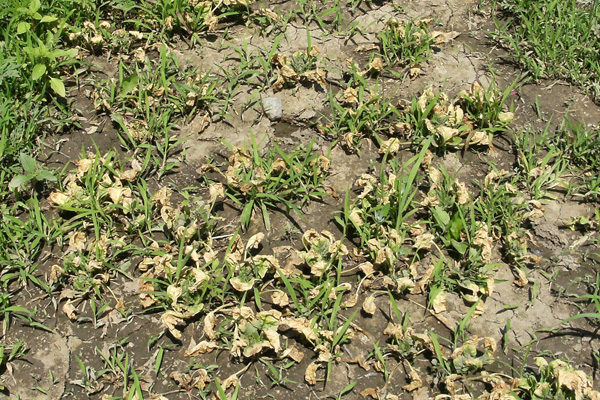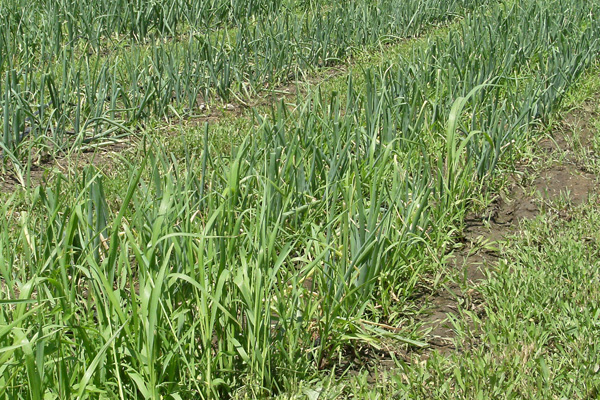University of Minnesota Agriculture student Ruth Burke is spending this summer interning at a CSA farm called Cramer Organics of Delano, MN. Throughout the growing season, she’ll share weekly updates about the experience with readers of the Heavy Table.
Part 6: “Rain, Rain, Go Away!”
Not three weeks ago we were steadfastly praying for rain. It seemed as if every passing rainstorm teetered on the edges of our farm, but never actually delivered. The farm was so dry that I would be covered in dust by the end of the day. Even my feet would be dirty (though they were encased in wool socks and shoes!). We were irrigating every day and even one day’s break would have been nice.
Then the storms started to come. One rain shower after another, for the last three weeks, have pelted the farm. Now we have small ponds where fields should be, and we find ourselves praying that the rain stops. Every time we start to dry out, another storm rolls through that leaves small rivers in our beds and puddles in our fields. It would seem that our earlier prayers were answered, and then some.

Constant and continual rain has a few rather nasty drawbacks. First and foremost, just like us, most plants can’t breathe underwater. Therefore, with only a couple of days with submerged roots, plants will suffer. It is very sad to see previously healthy spinach plants turn yellow and then die (see above). This happens for two main reasons: One, the plant can’t get oxygen, and two, the nutrients surrounding the roots are either leached away or become unavailable due to the anaerobic conditions.
Rapid development of weeds is another drawback to continual rain. Weeds are very efficient at utilizing whichever nutrients happen to be available. When it rains, it seems as if, overnight, the weeds explode. Some of our beds have become so overgrown with weeds that you can’t see the actual plants — the only way to combat them is to get on our hands and knees and handpick them. This is not only time consuming and frustrating, but very tiring as well. Also, plants must compete with weeds for nutrients and resources. If weeds get to be too large, plants can wither and die because they are just no match for the much stronger weeds. The difference between plants in a weeded bed versus plants that are surrounded by weeds is remarkable.

Another downside is the development of disease. Bacterial and fungal diseases of plants do very well in cold, wet weather. Therefore, it is common to see an uptick in diseases that affect plants shortly after a cold, rainy period. Of particular concern are diseases like Fire Blight, Anthracnose, Damping off, Early and Late Blight, Powdery Mildew, and Gray Mold. Either fungi or bacteria cause these diseases, but they all share a common trait: They like periods of wetness and / or high humidity. They also can severely reduce your yields, depending on the plant. And once a disease is present in a field, it can come back year after year. This is one of the many reasons why farmers rotate their fields. Diseases tend to be species or genus specific; therefore, if you change the plants that are grown in each field every year, you can “starve” the disease out of existence.
What can you do when your fields are submerged in water? Well, most conventional farmers install what is known as “tile” in their fields. Tiling is essentially a system of underground “pipes” that siphon water off the fields and drain it into drainage ditches. (This is actually one of the largest contributors to groundwater and river pollution in the Midwest. A lot of chemicals and fertilizers are leached from the fields and spewed directly into our streams and rivers, which eventually reach large lakes, or even the ocean.) However, you can’t install tiling when your fields are already flooded, and installing tiling is costly and time consuming, especially when the event is a rare occurrence. I asked Joey if they have ever had this problem before and she replied that this is a first for the farm. So, tiling isn’t a very viable option.
For smaller puddles, straw and mulch do a great job of soaking up excess water. We spent a good deal of time last week spreading straw around some of our soggy tomato plants. Hopefully this helps. In the end, however, this is another one of those realities of community supported agriculture. As a shareholder, you agree to share both the good times and the bad times with the farmer. Well, this is a bad time. That’s the way it goes. However, I’ll bet that in a month, the weather will be so great that we’ll be swimming in produce and not water. Good times are coming, I promise.
(Visit our full archive of this feature)

Thanks for a really interesting story Ruth! Susan